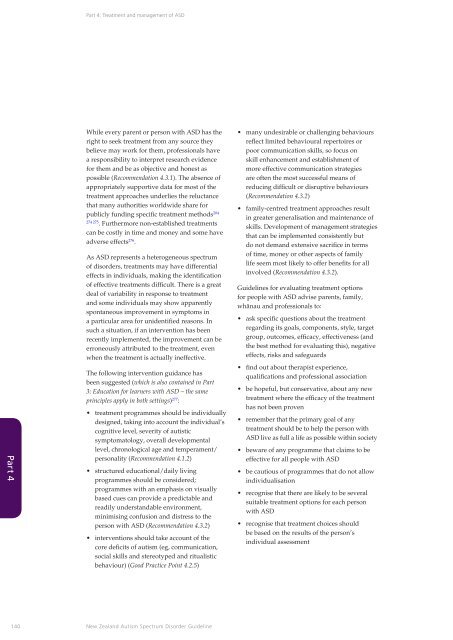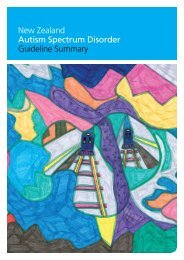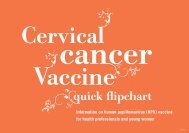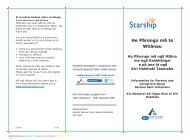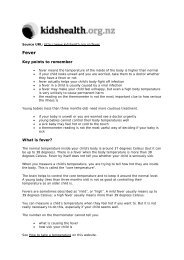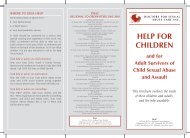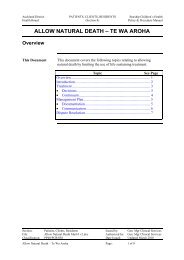New Zealand Autism Spectrum Disorder Guideline - Ministry of Health
New Zealand Autism Spectrum Disorder Guideline - Ministry of Health
New Zealand Autism Spectrum Disorder Guideline - Ministry of Health
You also want an ePaper? Increase the reach of your titles
YUMPU automatically turns print PDFs into web optimized ePapers that Google loves.
Part 4: Treatment and management <strong>of</strong> ASD<br />
Part 4<br />
While every parent or person with ASD has the<br />
right to seek treatment from any source they<br />
believe may work for them, pr<strong>of</strong>essionals have<br />
a responsibility to interpret research evidence<br />
for them and be as objective and honest as<br />
possible (Recommendation 4.3.1). The absence <strong>of</strong><br />
appropriately supportive data for most <strong>of</strong> the<br />
treatment approaches underlies the reluctance<br />
that many authorities worldwide share for<br />
publicly funding specific treatment methods 204<br />
274 275<br />
. Furthermore non-established treatments<br />
can be costly in time and money and some have<br />
adverse effects 276 .<br />
As ASD represents a heterogeneous spectrum<br />
<strong>of</strong> disorders, treatments may have differential<br />
effects in individuals, making the identification<br />
<strong>of</strong> effective treatments difficult. There is a great<br />
deal <strong>of</strong> variability in response to treatment<br />
and some individuals may show apparently<br />
spontaneous improvement in symptoms in<br />
a particular area for unidentified reasons. In<br />
such a situation, if an intervention has been<br />
recently implemented, the improvement can be<br />
erroneously attributed to the treatment, even<br />
when the treatment is actually ineffective.<br />
The following intervention guidance has<br />
been suggested (which is also contained in Part<br />
3: Education for learners with ASD – the same<br />
principles apply in both settings) 277 :<br />
• treatment programmes should be individually<br />
designed, taking into account the individual’s<br />
cognitive level, severity <strong>of</strong> autistic<br />
symptomatology, overall developmental<br />
level, chronological age and temperament/<br />
personality (Recommendation 4.1.2)<br />
• structured educational/daily living<br />
programmes should be considered;<br />
programmes with an emphasis on visually<br />
based cues can provide a predictable and<br />
readily understandable environment,<br />
minimising confusion and distress to the<br />
person with ASD (Recommendation 4.3.2)<br />
• interventions should take account <strong>of</strong> the<br />
core deficits <strong>of</strong> autism (eg, communication,<br />
social skills and stereotyped and ritualistic<br />
behaviour) (Good Practice Point 4.2.5)<br />
• many undesirable or challenging behaviours<br />
reflect limited behavioural repertoires or<br />
poor communication skills, so focus on<br />
skill enhancement and establishment <strong>of</strong><br />
more effective communication strategies<br />
are <strong>of</strong>ten the most successful means <strong>of</strong><br />
reducing difficult or disruptive behaviours<br />
(Recommendation 4.3.2)<br />
• family-centred treatment approaches result<br />
in greater generalisation and maintenance <strong>of</strong><br />
skills. Development <strong>of</strong> management strategies<br />
that can be implemented consistently but<br />
do not demand extensive sacrifice in terms<br />
<strong>of</strong> time, money or other aspects <strong>of</strong> family<br />
life seem most likely to <strong>of</strong>fer benefits for all<br />
involved (Recommendation 4.3.2).<br />
<strong>Guideline</strong>s for evaluating treatment options<br />
for people with ASD advise parents, family,<br />
whänau and pr<strong>of</strong>essionals to:<br />
• ask specific questions about the treatment<br />
regarding its goals, components, style, target<br />
group, outcomes, efficacy, effectiveness (and<br />
the best method for evaluating this), negative<br />
effects, risks and safeguards<br />
• find out about therapist experience,<br />
qualifications and pr<strong>of</strong>essional association<br />
• be hopeful, but conservative, about any new<br />
treatment where the efficacy <strong>of</strong> the treatment<br />
has not been proven<br />
• remember that the primary goal <strong>of</strong> any<br />
treatment should be to help the person with<br />
ASD live as full a life as possible within society<br />
• beware <strong>of</strong> any programme that claims to be<br />
effective for all people with ASD<br />
• be cautious <strong>of</strong> programmes that do not allow<br />
individualisation<br />
• recognise that there are likely to be several<br />
suitable treatment options for each person<br />
with ASD<br />
• recognise that treatment choices should<br />
be based on the results <strong>of</strong> the person’s<br />
individual assessment<br />
140<br />
<strong>New</strong> <strong>Zealand</strong> <strong>Autism</strong> <strong>Spectrum</strong> <strong>Disorder</strong> <strong>Guideline</strong>


